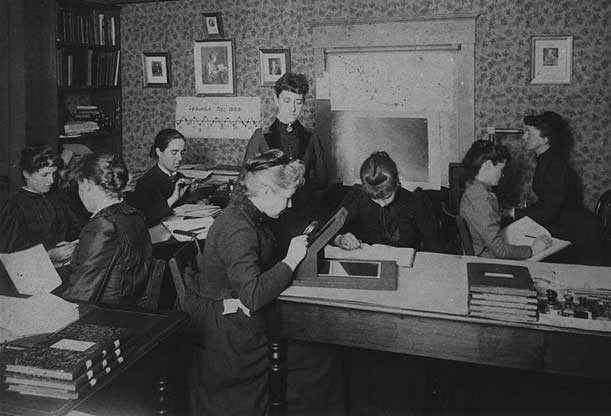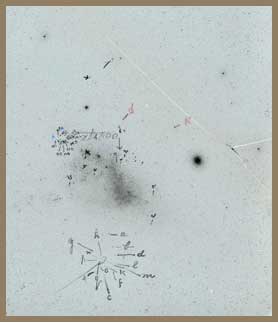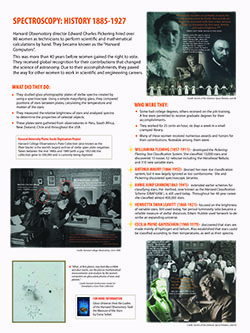
Harvard Computers
Harvard Observatory director Edward Charles Pickering hired more than 80 women as technicians to perform scientific and mathematical calculations by hand. They became known as the "Harvard Computers."
This was more than 40 years before women gained the right to vote. They received global recognition for their contributions that changed the science of astronomy. Due to their accomplishments, they paved the way for other women to work in scientific and engineering careers.

A group of women computers, directed by Williamina Fleming, back center standing.
[Credit: Harvard College Observatory, c1890]
WHAT DID THEY DO
 They studied glass photographic plates of stellar spectra created by using a spectroscope. Using a simple magnifying glass, they compared positions of stars between plates, calculating the temperature and motion of the stars.
They studied glass photographic plates of stellar spectra created by using a spectroscope. Using a simple magnifying glass, they compared positions of stars between plates, calculating the temperature and motion of the stars.- They measured the relative brightness of stars and analyzed spectra to determine the properties of celestial objects.
- These plates were gathered from observatories in Peru, South Africa, New Zealand, Chile and throughout the USA.
[right] "What, at first glance, may look like scribble and dust marks, are the precise mathematical measurements and analysis by the women computers on glass plate photos of stars and planets." Credit: Harvard-Smithsonian Center for Astrophysics, Glass Plate Collection
Harvard University Plates Stacks Digitization Project
Harvard College Observatory’s Plate Collection (also known as the Plate Stacks) is the world’s largest archive of stellar glass plate negatives. Taken between the mid 1880s and 1989 (with a gap 1953-68) the collection grew to 500,000 and is currently being digitized.
WHO WERE THEY
- Some had college degrees, others received on-the job-training.
- A few were permitted to receive graduate degrees for their accomplishments.
- They worked for 25 cents an hour, six days a week in a smallcramped library.
- Many of these women received numerous awards and honors for their contributions. Noteable among them were:
WILLIAMENA FLEMING (1857-1911) - developed the Pickering-Fleming Star Classification System. She classified 10,000 stars and discovered 10 novae, 52 nebulae including the Horsehead Nebula, and 310 new variable stars.
ANTONIA MAURY (1866-1952)- devised her own star classification system, but it was largely ignored as too cumbersome. She and Pickering discovered spectroscopic binaries.
ANNIE JUMP CANNON(1863-1941)- extended earlier schemes for classifying stars. Her method, now known as the Harvard Classification Scheme [OBAFGKM ], is still used today. Throughout her 40 year career she classified almost 400,000 stars.
HENRIETTA SWAN LEAVITT (1868-1921)- focused on the brightness of variable stars. Still used today, her period-luminosity ratio became a reliable measure of stellar distances. Edwin Hubble used herwork to describe an expanding universe.
CECILIA PAYNE-GAPOSCHKIN (1900-1979)- discovered that stars are made mainly of hydrogen and helium. Also established that stars could be classified according to their temperatures, as well as their spectra.
FOR MORE INFORMATION
|
 Glass Universe: How the Ladies of the Harvard Observatory Took the Measure of the Stars by Dava Sobel. Glass Universe: How the Ladies of the Harvard Observatory Took the Measure of the Stars by Dava Sobel. |
